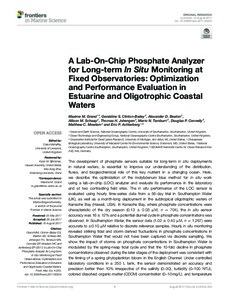| dc.contributor.author | Grand, Maxime M. | |
| dc.contributor.author | Clinton-Bailey, Geraldine S. | |
| dc.contributor.author | Beaton, Alexander D. | |
| dc.contributor.author | Schaap, Allison M. | |
| dc.contributor.author | Johengen, Thomas H. | |
| dc.contributor.author | Tamburri, Mario N. | |
| dc.contributor.author | Connelly, Douglas P. | |
| dc.contributor.author | Mowlem, Matthew C. | |
| dc.contributor.author | Achterberg, Eric P. | |
| dc.coverage.spatial | Southampton Water | en_US |
| dc.coverage.spatial | Kaneohe Bay | en_US |
| dc.date.accessioned | 2020-05-22T13:53:06Z | |
| dc.date.available | 2020-05-22T13:53:06Z | |
| dc.date.issued | 2017 | |
| dc.identifier.citation | Grand, M.M.; Clinton-Bailey, G,S,; Beaton, AD, Schaap, AM., Johengen, T.H.; Tamburri, M.N.;
Connelly, D.P.; Mowlem, M.C. and
Achterberg, E.P. (2017) A Lab-On-Chip Phosphate Analyzer for Long-term In Situ Monitoring at Fixed
Observatories: Optimization and Performance Evaluation in Estuarine and Oligotrophic Coastal Waters.
Frontiers in Marine Science, 4:255, 16pp. DOI: 10.3389/fmars.2017.00255 | en_US |
| dc.identifier.uri | http://hdl.handle.net/11329/1338 | |
| dc.identifier.uri | http://dx.doi.org/10.25607/OBP-844 | |
| dc.description.abstract | The development of phosphate sensors suitable for long-term in situ deployments
in natural waters, is essential to improve our understanding of the distribution,
fluxes, and biogeochemical role of this key nutrient in a changing ocean. Here,
we describe the optimization of the molybdenum blue method for in situ work
using a lab-on-chip (LOC) analyzer and evaluate its performance in the laboratory
and at two contrasting field sites. The in situ performance of the LOC sensor is
evaluated using hourly time-series data from a 56-day trial in Southampton Water
(UK), as well as a month-long deployment in the subtropical oligotrophic waters of
Kaneohe Bay (Hawaii, USA). In Kaneohe Bay, where phosphate concentrations were
characteristic of the dry season (0.13 ± 0.03 μM, n = 704), the in situ sensor
accuracy was 16 ± 12% and a potential diurnal cycle in phosphate concentrations was
observed. In Southampton Water, the sensor data (1.02 ± 0.40 μM, n = 1,267) were
accurate to ±0.10 μM relative to discrete reference samples. Hourly in situ monitoring
revealed striking tidal and storm derived fluctuations in phosphate concentrations in
Southampton Water that would not have been captured via discrete sampling. We
show the impact of storms on phosphate concentrations in Southampton Water is
modulated by the spring-neap tidal cycle and that the 10-fold decline in phosphate
concentrations observed during the later stages of the deployment was consistent with
the timing of a spring phytoplankton bloom in the English Channel. Under controlled
laboratory conditions in a 250 L tank, the sensor demonstrated an accuracy and
precision better than 10% irrespective of the salinity (0–30), turbidity (0–100 NTU),
colored dissolved organic matter (CDOM) concentration (0–10mg/L), and temperature (5–20◦C) of the water (0.3–13 μM phosphate) being analyzed. This work demonstrates
that the LOC technology is mature enough to quantify the influence of stochastic events
on nutrient budgets and to elucidate the role of phosphate in regulating phytoplankton
productivity and community composition in estuarine and coastal regimes. | en_US |
| dc.language.iso | en | en_US |
| dc.rights | Attribution 4.0 International | * |
| dc.rights.uri | http://creativecommons.org/licenses/by/4.0/ | * |
| dc.subject.other | In situ phosphate analysis | en_US |
| dc.subject.other | Molybdenum blue | en_US |
| dc.subject.other | Microfluidics | en_US |
| dc.subject.other | Phospate sensor | en_US |
| dc.subject.other | Nutrient sensor challenge | en_US |
| dc.title | A Lab-On-Chip Phosphate Analyzer for Long-term In Situ Monitoring at Fixed Observatories: Optimization and Performance Evaluation in Estuarine and Oligotrophic Coastal Waters, | en_US |
| dc.type | Journal Contribution | en_US |
| dc.description.refereed | Refereed | en_US |
| dc.format.pagerange | 16pp. | en_US |
| dc.identifier.doi | 10.3389/fmars.2017.00255 | |
| dc.subject.parameterDiscipline | Parameter Discipline::Chemical oceanography::Nutrients | en_US |
| dc.subject.instrumentType | Instrument Type Vocabulary::nutrient analysers | en_US |
| dc.bibliographicCitation.title | Frontiers in Marine Science | en_US |
| dc.bibliographicCitation.volume | 4 | en_US |
| dc.bibliographicCitation.issue | Article 255 | en_US |
| dc.description.sdg | 14.A | en_US |
| dc.description.eov | Nutrients | en_US |
| dc.description.maturitylevel | TRL 8 Actual system completed and "mission qualified" through test and demonstration in an operational environment (ground or space) | en_US |
| dc.description.bptype | Manual (incl. handbook, guide, cookbook etc) | en_US |
| dc.description.bptype | Standard Operating Procedure | en_US |
| obps.contact.contactname | Maxime M. Grand | |
| obps.contact.contactemail | m.grand@noc.soton.ac.uk | |
| obps.resourceurl.publisher | https://www.frontiersin.org/articles/10.3389/fmars.2017.00255/full | en_US |
 Repository of community practices in Ocean Research, Applications and Data/Information Management
Repository of community practices in Ocean Research, Applications and Data/Information Management

